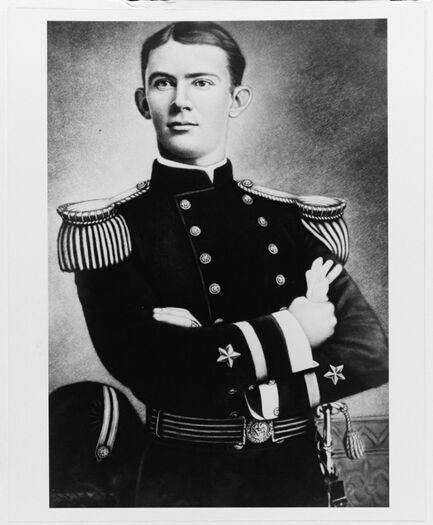JOHN R. MONAGHAN, ENS, USN
John Monaghan '95
Lucky Bag
From the 1895 Lucky Bag:
Monaghan
Spokane, Washington
N. A. Baseball Team, 1892, 1894. Class Baseball Team, 1892, 1893, 1894.
Monaghan
Spokane, Washington
N. A. Baseball Team, 1892, 1894. Class Baseball Team, 1892, 1893, 1894.
Photographs
Loss
John was killed in action on April 1, 1899 during the Second Samoan Civil War.
Other Information
From Naval History and Heritage Command:
John Robert Monaghan, born on 26 March 1873 in Chawelah, Wash., his parents were James and Margaret (McCool) Monaghan. His parents desired to give him superior educational advantages under the auspices of the church to which they belonged, but the facilities for Catholic instruction were limited in Washington in those days, so that the boy at the age of eleven was sent to the school of the Christian Brothers -- St. Joseph Academy, at Oakland, Calif. He attended that school and also another brothers' school in Portland, Ore., until the Jesuit Fathers established Gonzaga College in Spokane in 1887.
Monaghan then enrolled as one of the first eighteen students and after four years spent in that institution, he took the examination held in Spokane in 1891 for the Military Academy at West Point and the Naval Academy at Annapolis, receiving the highest percentage in each of these examinations, so that he was entitled to make his choice of appointments. Although it was his original wish to go to West Point, he generously waived that preference in favor of the next applicant, the son of an old Army officer who heartily desired the appointment. He received his appointment to the Naval Academy on 7 September 1891. Classmates wrote "I've got a drop of the Irish blood in me mesilf," as a nod to his ancestry, and he played baseball at the Academy, on both the class team (1892, 1893 and 1894), and on the Academy nine (1892 and 1894), playing right field during the 1894 season. He graduated in June 1895, the first from the state of Washington to graduate from the Naval Academy.
As a passed midshipman he served on board the cruiser Olympia (Cruiser No. 6), flagship of the Asiatic Station. He was promoted to ensign in July 1897 and was assigned to the monitor Monadnock and the gunboat Alert. He was later transferred to the cruiser Philadelphia (Cruiser No. 4), flagship of the Pacific Station in July 1898. Calling at Apia, Samoa, on 6 March 1899, Philadelphia encountered an unstable political climate, created by rival native factions and spurred on by German intrigue, which soon erupted into open hostility.
During a combined reconnaissance of Americans, British, and Samoans near Apia on 1 April 1899, the American detachment, from Philadelphia, under the command of Lt. Philip V. Lansdale, came under fire from hostile rebel Samoans under Chief Mataafa "which it was impossible to withstand”. During the ensuing retreat, Lansdale fell, wounded, as he attempted to cover the retreat with a machine gun. Monaghan seized a rifle "from a disabled man [to make] a brave defense." The Samoans rushed them. Ensign Monaghan, one observer later wrote, "stood steadfast by his wounded superior and friend; one rifle against many, one brave man against a score of savages. He knew he was doomed. He could not yield. He died in heroic performance of duty..."
The remains of Ensign Monaghan were brought back to the United States on Philadelphia and interred in Spokane, where every honor was paid his memory. On 25 October 1906, a bronze statue was unveiled in Spokane, by his sister, Agnes, which was given by the citizens of the state of Washington.
From researcher Kathy Franz:
John was one of the first white children born in Chewelah, Washington. His father James was a pioneer in the Spokane valley, ran a ferry across the river, and was a trader with the Indians.
During John's time at the Naval Academy, he spent two years on sea service on the Olympia in the Asiatic station.
In June 1897, John received his commission and was ordered to the Monadnock at Portland. He was later transferred to the Alert on the Central American coast at Nicaragua. While serving on the Alert, he met Lieutenant Philip Lansdale ('77). On being congratulated by a friend on his transfer, he replied: “What have I done that you should think so meanly of me as to think I would shirk danger in the service of my country? Look at Bagley and Breckinridge, my classmates, who have died gloriously for the flag they love, while I am denied that privilege. No, it is not a sad but a glorious thing, and all any man could ask, to give his life for his country.” Per the Spokane Chronicle, June 27, 1899.
In March 1898, John was on the Philadelphia in San Diego.
On April 1, 1899, the attack on the group of Americans and British in Samoa found them outnumbered 8 to 1. The three officers killed had been decapitated: John, Lansdale, and Lieutenant Freeman of the British gunboat Tauranga. They were buried headless with military honors at Mulinuu with the two American sailors and two British sailors whose ears had been cut off. The officers' heads were subsequently brought back by some French priests and buried with the officers' bodies.
Robert Louis Stevenson lived his final years on Samoa. He documented the political struggles directly in the book A Footnote to History: Eight Years of Trouble in Samoa. 214 sailors and 150 Friendlies were ambushed by the rebels on April 1 on a German plantation. The sailors and Friendlies had burned two villages on their way to Vailele. The Friendlies immediately deserted and ran to the beach. It was an old Samoan custom to cut off heads of their enemies.
The Spokane Chronicle, April 12, 1899, interviewed John's uncle, Edward O'Shea. “Bobby was the finest boy I ever knew. He was handsome, brave, modest – everything that was desirable in a perfect gentleman. At home I never saw his equal, and he was the apple of his father's eye and the darling of his mother.
“Mrs. Monaghan, it will be remembered, died four years ago. At that time and during the long illness of his mother Bobby was at home. He had no sooner reached the house then he took off his uniform and began waiting on his mother. He looked after all of the household cares, and was the best nurse that ever lived. During this sickness his third severe examination was approaching and his father and mother were greatly worried lest he fail. To their astonishment he passed the ordeal with higher honors than on either of the preceding examinations.
“One of the greatest regrets of Mr. Monaghan and Bobby was his inability to be present during the Cuban engagements in the late war. He was a frontier grown boy – a fighter by nature. I am satisfied it was his daring nature that caused his death, for if there was any danger he was bound to be in the thick of it.
“Unlike most young boys, Bobby never made a display of himself, much to the joy of his mother and father. When off duty he never wore his uniform, and as for posing on the street corners, like many young men from military schools, decked out in his military raiment, nothing to him could have been more displeasing. During his stay in the city he would come down town in the clothing he wore at home. Only once during his visit did he wear his uniform, and that was at a small party given at our house. The girls wanted to see how he would look, and after persistent coaxing he was induced to appear in his officer's costume.
“There is another pleasing instance of the young man's dislike for show which recalls itself to my mind. During one of the visits of his ship to Boston young 'Bobby' was sought by Miss O'Shea then pianist in the New England Conservatory of Music orchestra, to attend a musical and social function for which she had obtained tickets for him. It was to be a swell affair and she, supported by other young lady friends who had made 'Bobby's' acquaintance, specified that he must appear in his officer's uniform. He did not want to go under the conditions, but was finally prevailed upon, after a good deal of coaxing, to do so.”
On June 24, 1899, the Seattle Post-Intelligencer published a letter from Lieutenant Ambrose B. Wyckoff, retired (Class of 1864.) He supported the monument to be made in John's honor and enclosed $5. He ended his letter urging those in Sunday school to be reminded of the words: “Greater love hath no man than this, that a man lay down his life for his friends.” The newspaper acknowledged that Spokane had already started a fund, and all subscriptions along with those from the Seattle newspaper would be sent to Spokane.
John's father James later made his fortune in selling real estate. H had been president and manager of the Cariboo Mining, Milling and Smelting Company in the Camp McKinney District. John had planned to leave the service after the hostilities ended to help his father in business. John's parents were both born in Ireland. Their home, the Monaghan Mansion, is now the Music Building on the Gonzaga University campus.
John was survived by his father and five siblings; he is buried in Washington. He is listed on the killed in action panel in the front of Memorial Hall under the heading "SAMOAN CAMPAIGN 1899."
The "Register of Commissioned and Warrant Officers of the United States Navy and Marine Corps" was published annually from 1815 through at least the 1970s; it provided rank, command or station, and occasionally billet until the beginning of World War II when command/station was no longer included. Scanned copies were reviewed and data entered from the mid-1840s through 1922, when more-frequent Navy Directories were available.
The Navy Directory was a publication that provided information on the command, billet, and rank of every active and retired naval officer. Single editions have been found online from January 1915 and March 1918, and then from three to six editions per year from 1923 through 1940; the final edition is from April 1941.
The entries in both series of documents are sometimes cryptic and confusing. They are often inconsistent, even within an edition, with the name of commands; this is especially true for aviation squadrons in the 1920s and early 1930s.
Alumni listed at the same command may or may not have had significant interactions; they could have shared a stateroom or workspace, stood many hours of watch together, or, especially at the larger commands, they might not have known each other at all. The information provides the opportunity to draw connections that are otherwise invisible, though, and gives a fuller view of the professional experiences of these alumni in Memorial Hall.
Namesake
USS Monaghan (Destroyer No. 32) was named for John; the ship was sponsored by his sister.
USS Monaghan (DD 354) was also named for him; this ship was sponsored by his niece.
Related Articles
Philip Lansdale '77 was also lost in this action.

The "category" links below lead to lists of related Honorees; use them to explore further the service and sacrifice of alumni in Memorial Hall.
